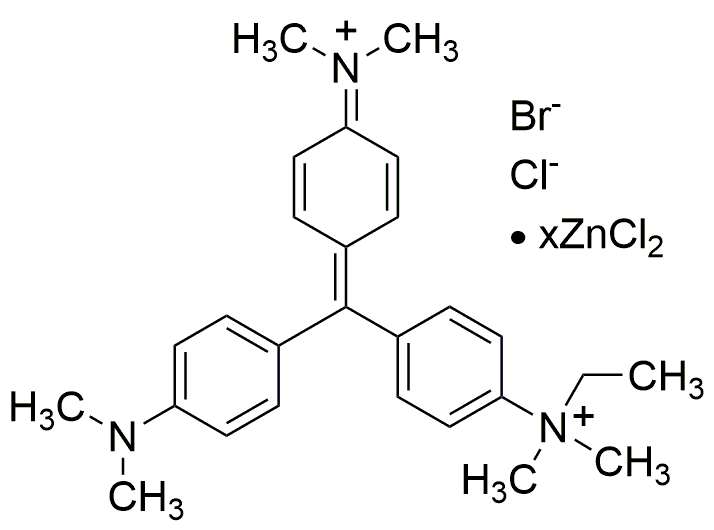Methyl green, zinc chloride salt is widely utilized in research focused on:
- Histology and Cytology: This compound serves as a vital stain for biological tissues, allowing researchers to visualize cellular structures under a microscope. Its ability to bind to nucleic acids makes it particularly useful in identifying DNA and RNA in cells.
- Biochemical Assays: Methyl green is employed in various biochemical assays to quantify nucleic acid concentrations. Its sensitivity and specificity help researchers obtain accurate measurements, enhancing the reliability of experimental results.
- Pharmaceutical Research: In drug development, this compound is used to assess the interaction of new drugs with nucleic acids. Understanding these interactions can lead to the discovery of novel therapeutic agents.
- Environmental Monitoring: Methyl green can be applied in environmental studies to detect and quantify pollutants that interact with biological systems, providing insights into ecosystem health and contamination levels.
- Educational Purposes: This chemical is commonly used in educational laboratories to teach students about staining techniques and microscopy, making complex biological concepts more accessible and engaging.
General Information
Properties
Safety and Regulations
Applications
Methyl green, zinc chloride salt is widely utilized in research focused on:
- Histology and Cytology: This compound serves as a vital stain for biological tissues, allowing researchers to visualize cellular structures under a microscope. Its ability to bind to nucleic acids makes it particularly useful in identifying DNA and RNA in cells.
- Biochemical Assays: Methyl green is employed in various biochemical assays to quantify nucleic acid concentrations. Its sensitivity and specificity help researchers obtain accurate measurements, enhancing the reliability of experimental results.
- Pharmaceutical Research: In drug development, this compound is used to assess the interaction of new drugs with nucleic acids. Understanding these interactions can lead to the discovery of novel therapeutic agents.
- Environmental Monitoring: Methyl green can be applied in environmental studies to detect and quantify pollutants that interact with biological systems, providing insights into ecosystem health and contamination levels.
- Educational Purposes: This chemical is commonly used in educational laboratories to teach students about staining techniques and microscopy, making complex biological concepts more accessible and engaging.
Documents
Safety Data Sheets (SDS)
The SDS provides comprehensive safety information on handling, storage, and disposal of the product.
Product Specification (PS)
The PS provides a comprehensive breakdown of the product’s properties, including chemical composition, physical state, purity, and storage requirements. It also details acceptable quality ranges and the product's intended applications.
Certificates of Analysis (COA)
Search for Certificates of Analysis (COA) by entering the products Lot Number. Lot and Batch Numbers can be found on a product’s label following the words ‘Lot’ or ‘Batch’.
*Catalog Number
*Lot Number
Certificates Of Origin (COO)
This COO confirms the country where the product was manufactured, and also details the materials and components used in it and whether it is derived from natural, synthetic, or other specific sources. This certificate may be required for customs, trade, and regulatory compliance.
*Catalog Number
*Lot Number
Safety Data Sheets (SDS)
The SDS provides comprehensive safety information on handling, storage, and disposal of the product.
DownloadProduct Specification (PS)
The PS provides a comprehensive breakdown of the product’s properties, including chemical composition, physical state, purity, and storage requirements. It also details acceptable quality ranges and the product's intended applications.
DownloadCertificates of Analysis (COA)
Search for Certificates of Analysis (COA) by entering the products Lot Number. Lot and Batch Numbers can be found on a product’s label following the words ‘Lot’ or ‘Batch’.
*Catalog Number
*Lot Number
Certificates Of Origin (COO)
This COO confirms the country where the product was manufactured, and also details the materials and components used in it and whether it is derived from natural, synthetic, or other specific sources. This certificate may be required for customs, trade, and regulatory compliance.


